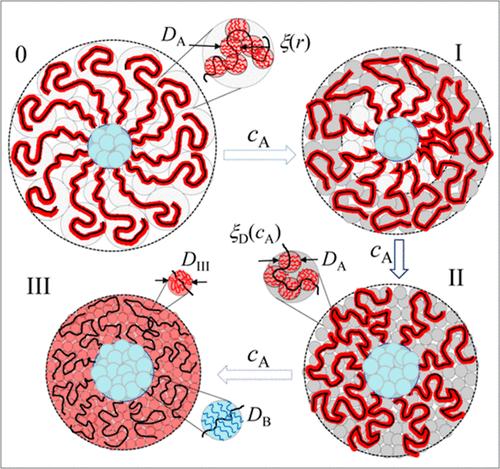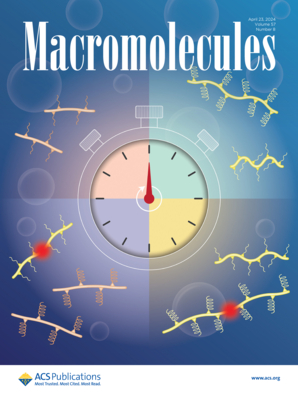二嵌段共聚物胶束与底嵌段的溶液。缩放模型
IF 5.1
1区 化学
Q1 POLYMER SCIENCE
引用次数: 0
摘要
我们提出了一种缩放理论,它描述了在溶液中由带有底丛(bottlebrush)嵌段的二嵌段共聚物形成的星形胶束的平衡特性。在稀释和半稀释溶液中,嵌段被设想为尺寸为 DA 和 DB 的防渗超级球状线性链。根据块体 "厚度 "的比率(DA/DB),胶束会表现出与溶液浓度不同的幂律关系。我们证明,与线性嵌段的二嵌段共聚物相比,嵌段的分枝增加了状态图中不同状态的数量。特别是,在浓溶液中,可溶性嵌段 A 的厚度 DA 会减小,胶束的重排类似于二嵌段共聚物熔体中的球形畴,电晕嵌段中单体单元的大小与浓度有关。在半稀释溶液和浓缩溶液中,星形胶束基本上保持不渗透状态,并呈现准球形状态。理论预测与实验结果进行了对比。本文章由计算机程序翻译,如有差异,请以英文原文为准。

Solutions of Diblock Copolymer Micelles with Bottlebrush Blocks. Scaling Model
We present a scaling theory describing equilibrium properties of starlike micelles formed by a diblock copolymer with bottlebrush (bb) blocks in solutions. In dilute and semidilute solutions, the blocks are envisioned as linear chains of impermeable superblobs with sizes DA and DB. Depending on the ratio of block “thicknesses”, DA/DB, micelles can exhibit different power law dependences on solution concentration. We demonstrate that bb branching of blocks increases the number of different regimes in the diagram of states compared with diblock copolymers with linear blocks. In particular, in concentrated solution, thickness DA of soluble block A decreases and micelles rearrange similarly to spherical domains in melts of diblock copolymer with the concentration-dependent size of the monomer unit in the corona block. In both the semidilute and concentrated solutions, starlike micelles remain essentially impermeable and exhibit quasi-globular regimes. The theoretical predictions are contrasted to experiments.
求助全文
通过发布文献求助,成功后即可免费获取论文全文。
去求助
来源期刊

Macromolecules
工程技术-高分子科学
CiteScore
9.30
自引率
16.40%
发文量
942
审稿时长
2 months
期刊介绍:
Macromolecules publishes original, fundamental, and impactful research on all aspects of polymer science. Topics of interest include synthesis (e.g., controlled polymerizations, polymerization catalysis, post polymerization modification, new monomer structures and polymer architectures, and polymerization mechanisms/kinetics analysis); phase behavior, thermodynamics, dynamic, and ordering/disordering phenomena (e.g., self-assembly, gelation, crystallization, solution/melt/solid-state characteristics); structure and properties (e.g., mechanical and rheological properties, surface/interfacial characteristics, electronic and transport properties); new state of the art characterization (e.g., spectroscopy, scattering, microscopy, rheology), simulation (e.g., Monte Carlo, molecular dynamics, multi-scale/coarse-grained modeling), and theoretical methods. Renewable/sustainable polymers, polymer networks, responsive polymers, electro-, magneto- and opto-active macromolecules, inorganic polymers, charge-transporting polymers (ion-containing, semiconducting, and conducting), nanostructured polymers, and polymer composites are also of interest. Typical papers published in Macromolecules showcase important and innovative concepts, experimental methods/observations, and theoretical/computational approaches that demonstrate a fundamental advance in the understanding of polymers.
 求助内容:
求助内容: 应助结果提醒方式:
应助结果提醒方式:


